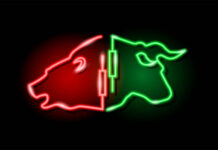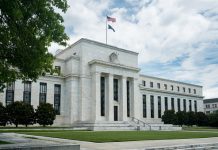In focus today
In the US, the NFIB’s Small Business Optimism index is scheduled for release. Additionally, focus will be on any softening of the Trump administration’s trade policy stance or any verbal intervention from the Fed.
In Denmark, we will receive February’s industrial production figures. January saw an 11.9% decline (SA), an unusually large drop even for Denmark’s volatile industrial production. Despite the uncertainty surrounding the drivers – this decline likely does not indicate a fundamental shift in Danish manufacturing.
The day also features a string of ECB speakers, which could add some nuances on their thinking following the recent tightening of financial conditions.
Economic and market news
What happened overnight
In the US, President Trump announced direct talks with Iran regarding Tehran’s nuclear program, scheduled for Saturday. Amid heightened tensions, Trump warned of significant risks for Iran if negotiations fail. Iran currently rejects the approach for direct talks.
In China, the commerce ministry has pledged to implement further retaliatory measures if President Trump proceed with his threat to impose an additional 50% tariff on Chinese goods. China asserts its readiness to “fight to the end”.
What happened yesterday
In the US, rumours of a 90-day tariff pause led to a significant rally in equities yesterday afternoon. The rumours were later debunked by the White House, but the market action clearly emphasized the significance any softening of the trade policy stance could have. Later, President Trump threatened to impose a 50% additional tariff on China due to its retaliatory measures announced on Friday. These new tariffs could be effective tomorrow alongside the retaliatory tariffs announced last week.
In the euro area, investor confidence declined in the first survey following Trump’s tariff hammer. The Sentix investor confidence indicator fell sharply from -2.9 to -19.5, marking its lowest level since October 2023. Conducted between 3 April and 5 April, this survey provides an early indication of what to expect from other sentiment indicators. For additional insights, see Euro Area Macro Monitor, 7 April.
In Sweden, The March budget outcome for the central government showed a result in line with the forecast. The accumulated deviation since the latest borrowing report therefore still amounts to a net borrowing requirement of SEK 4.8bn (i.e. slightly larger deficit than forecasted). On top of this, the SNDO will have to add the recently presented fiscal stimulus, including the announced increased defence spending, when they present the next borrowing report on 22 May. We expect the increased borrowing requirement will result in the SNDO raising the SGB auction volumes.
In geopolitics, the European Commission has proposed a “zero-for-zero” tariff for industrial goods to avert a trade war with the US, as EU ministers focus on negotiations while preparing targeted countermeasures. With impending US tariffs of 25% on steel, aluminium, cars, and 20% on other goods, the EU plans to impose 25% tariffs on a range of goods taking effect between 15 April and 1 December, depending on the product. Bourbon, wine and dairy products have been removed from the tariff list following lobbying by EU members to protect their alcohol industries. EU governments are expected to approve the list on Wednesday. Von der Leyen has reaffirmed the EU’s remained commitment to negotiation efforts with the US, while signalling readiness to retaliate against the tariff increases, reflecting a consistent approach in managing trade tensions.
Equities: What a ride in equities. European and Nordic markets started and ended the day in a sharp fall. Intraday moves were extraordinary, as a misunderstanding of a tariff pause temporarily sent equities higher – only to fall back again when White House refuted the report. Most European and Nordic indices closed around -5%, with Stoxx 600 down -16% since peak and other surfing close to bear market territory. This was a capitulation session without a clearcut preference between sectors and styles. Investors sold what they could, even typical safe havens like telcos and gold prices. Just like what is typically the case after a capitulation session, futures markets are indicating a 2% rebound today.
The US session was very different. Indexes close to unchanged, with S&P 500 -0.2%. Investors stopped trading on the recession risk and started trading on the rising yields. Hence, sector performance was different, with yield sensitive sectors like real estate and utilities selling off while oversold cyclicals like banks and Mag 7 outperforming (and some sectors even in green!). In fact, 157 of the 500 S&P companies were higher. US futures are 1-2% higher this morning and as so, on track to outperform Europe the last month.
Asian markets are in big moves today, with Nikkei 225 rising 5% on what seems like successful negotiations with Trump. Chinese and Korean equities mildly higher as well, despite the new tariff threats.
FI&FX: Risky assets were under pressure from the beginning of the week, as the Chinese retaliatory tariffs and Trump’s firm stance on implementing aggressive tariffs over the weekend led to sour sentiment. However, the mood changed drastically in the afternoon due to the – presumably – fake news that the US administration is considering a 90-day tariff pause. Even though the rumours were quickly debunked, hopes for a less severe outcome of the trade war supported equities for the remainder of the session with the S&P 500 turning a -5% initial drop into a marginal decline of just 0.2%. The DXY index gained 0.5% throughout the session, while haven currencies such as JPY were slightly weaker. Trump’s threats of assigning an additional 50% tariff on Chinese goods only led to a modest 0.5% rise in USD/CNY. In scandies FX, yesterday saw a 1.5% rise in EUR/NOK, while EUR/DKK rose to the highest level since 2020. EUR/SEK was close to unchanged. The US Treasury curve bear-steepened with the 10Y yield rising almost 20bp throughout the session. Brent is slightly higher at USD65/bbl. Asian equities are significantly up this morning with NIKKEI 225 recording a 6% rise, while Chinese indices have gained 1-2%. European equity futures point towards a 2.5% rise at the market opening.














